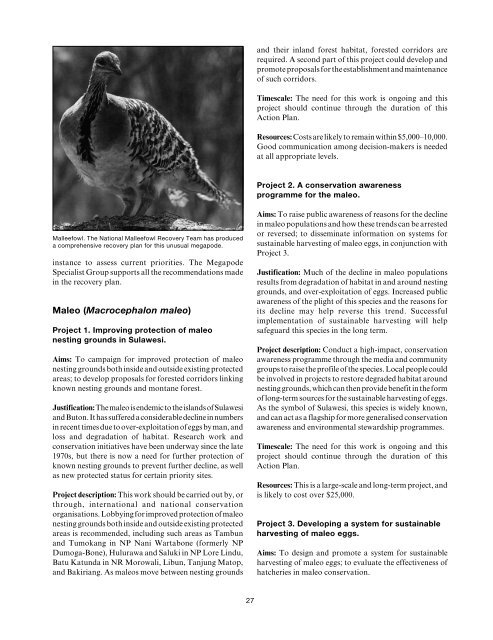Megapodes: Status Survey and Conservation Action Plan ... - IUCN
Megapodes: Status Survey and Conservation Action Plan ... - IUCN
Megapodes: Status Survey and Conservation Action Plan ... - IUCN
You also want an ePaper? Increase the reach of your titles
YUMPU automatically turns print PDFs into web optimized ePapers that Google loves.
<strong>and</strong> their inl<strong>and</strong> forest habitat, forested corridors are<br />
required. A second part of this project could develop <strong>and</strong><br />
promote proposals for the establishment <strong>and</strong> maintenance<br />
of such corridors.<br />
Timescale: The need for this work is ongoing <strong>and</strong> this<br />
project should continue through the duration of this<br />
<strong>Action</strong> <strong>Plan</strong>.<br />
Resources: Costs are likely to remain within $5,000–10,000.<br />
Good communication among decision-makers is needed<br />
at all appropriate levels.<br />
Project 2. A conservation awareness<br />
programme for the maleo.<br />
Malleefowl. The National Malleefowl Recovery Team has produced<br />
a comprehensive recovery plan for this unusual megapode.<br />
instance to assess current priorities. The Megapode<br />
Specialist Group supports all the recommendations made<br />
in the recovery plan.<br />
Maleo (Macrocephalon maleo)<br />
Project 1. Improving protection of maleo<br />
nesting grounds in Sulawesi.<br />
Aims: To campaign for improved protection of maleo<br />
nesting grounds both inside <strong>and</strong> outside existing protected<br />
areas; to develop proposals for forested corridors linking<br />
known nesting grounds <strong>and</strong> montane forest.<br />
Justification: The maleo is endemic to the isl<strong>and</strong>s of Sulawesi<br />
<strong>and</strong> Buton. It has suffered a considerable decline in numbers<br />
in recent times due to over-exploitation of eggs by man, <strong>and</strong><br />
loss <strong>and</strong> degradation of habitat. Research work <strong>and</strong><br />
conservation initiatives have been underway since the late<br />
1970s, but there is now a need for further protection of<br />
known nesting grounds to prevent further decline, as well<br />
as new protected status for certain priority sites.<br />
Project description: This work should be carried out by, or<br />
through, international <strong>and</strong> national conservation<br />
organisations. Lobbying for improved protection of maleo<br />
nesting grounds both inside <strong>and</strong> outside existing protected<br />
areas is recommended, including such areas as Tambun<br />
<strong>and</strong> Tumokang in NP Nani Wartabone (formerly NP<br />
Dumoga-Bone), Hulurawa <strong>and</strong> Saluki in NP Lore Lindu,<br />
Batu Katunda in NR Morowali, Libun, Tanjung Matop,<br />
<strong>and</strong> Bakiriang. As maleos move between nesting grounds<br />
Aims: To raise public awareness of reasons for the decline<br />
in maleo populations <strong>and</strong> how these trends can be arrested<br />
or reversed; to disseminate information on systems for<br />
sustainable harvesting of maleo eggs, in conjunction with<br />
Project 3.<br />
Justification: Much of the decline in maleo populations<br />
results from degradation of habitat in <strong>and</strong> around nesting<br />
grounds, <strong>and</strong> over-exploitation of eggs. Increased public<br />
awareness of the plight of this species <strong>and</strong> the reasons for<br />
its decline may help reverse this trend. Successful<br />
implementation of sustainable harvesting will help<br />
safeguard this species in the long term.<br />
Project description: Conduct a high-impact, conservation<br />
awareness programme through the media <strong>and</strong> community<br />
groups to raise the profile of the species. Local people could<br />
be involved in projects to restore degraded habitat around<br />
nesting grounds, which can then provide benefit in the form<br />
of long-term sources for the sustainable harvesting of eggs.<br />
As the symbol of Sulawesi, this species is widely known,<br />
<strong>and</strong> can act as a flagship for more generalised conservation<br />
awareness <strong>and</strong> environmental stewardship programmes.<br />
Timescale: The need for this work is ongoing <strong>and</strong> this<br />
project should continue through the duration of this<br />
<strong>Action</strong> <strong>Plan</strong>.<br />
Resources: This is a large-scale <strong>and</strong> long-term project, <strong>and</strong><br />
is likely to cost over $25,000.<br />
Project 3. Developing a system for sustainable<br />
harvesting of maleo eggs.<br />
Aims: To design <strong>and</strong> promote a system for sustainable<br />
harvesting of maleo eggs; to evaluate the effectiveness of<br />
hatcheries in maleo conservation.<br />
27
















